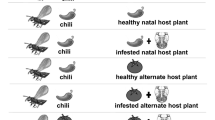Abstract
The behaviors of female Eretmocerus sp. nr. californiens raised from Bemisia argentifolii Bellows & Perring on melon, Cucumis melo L., were analysed on four different host plant species (cotton, melon, sweet potato and Abutilon theophrasti Medic). Comparison with previously published results of similarly treated females reared from sweet potato plants showed performance related differences leading to oviposition. In the present study, the generalized behavioral pathway (walking, host- encounter, antennation, probing and oviposition) did not vary among host plant species for melon- reared parasitoid females. Host assessment by antennation leading to host acceptance for probing varied from 10.5- 12.3 sec among the host plant species with no host stage- related differences in duration. Initial and repeated (multiple probes on the same host nymph) probing events varied from 52.4 to 77.3 sec among host plant species and no stage- related differences were detected. Oviposition occurred under 62 % of the nymphs on cotton, 100 % of the nymphs on melon and 51 % of the nymphs on sweet potato under which the ovipositor was exserted. On cotton, melon and sweet potato proportionally fewer first instar nymphs were encountered than present, a larger proportion of the second instars that were encountered were subsequently antennated, and a larger proportion of second instars on cotton were then subsequently probed. For cotton, melon, and sweet potato, the overall frequency of oviposition was lower than reported in previous studies. Results from these studies showed that the greatest factor in influencing overall parasitism in laboratory experiments was the propensity of females to alight and remain to search for hosts on a particular host plant. The role of “pre- conditioning” parasitoids to be better- suited to a particular host or host plant species is discussed relative to the findings herein.
Résumé
Le comportement des femelles d’Eretmocerus sp. nr. californiens, élevées sur Bemisia argentifolii Bellows & Perring sur melon, Cucumis melo L., a été étudié avec 4 plantes hÔtes différentes (coton, melon, patate douce et AbutÏlon theophrasti Medic). La comparaison avec des résultats publiés antérieurement concernant des femelles élevées sur des plants de patate douce, montre des différences dans les séquences comportementales précédant l’oviposition. Dans la présente étude, l’ensemble des séquences comportementales (locomotion, rencontre de l’hÔte, exploration à l’aide des antennes, piqûre et oviposition) ne présente pas de différences entre plantes hÔtes pour les parasitoÏdes femelles élevés sur melon. L’examen de l’hÔte à l’aide des antennes, qui permet l’acceptation puis la piqûre varie de 10, 5 à 12, 3 s entre les plantes hÔtes, sans différence de durée liée au stade larvaire. La piqûre initiale et la piqûre répétée (piqûres multiples sur le mÊme hÔte au stade nymphe) durent de 52, 4 à 77, 3 s selon la plante, sans relation avec le stade de l’hÔte. Sur coton, l’oviposition a lieu dans 62 % des nymphes, sur melon 100 % et sur patate douce 51 % des nymphes dont le parasitoide a retiré son ovipositeur. Sur coton, melon et patate douce, moins de larves de premier stade que prévu sous une hypothèse de répartition au hasard ont été trouvées ; une plus grande proportion de larves de deuxième stade a été l’objet d’un examen antennaire et une plus grande proportion de larves de second stade a été ensuite piquée sur coton. Pour le coton, le melon et la patate douce, la fréquence totale d’oviposition était plus basse que celle notée dans des travaux antérieurs. Ces recherches montrent qu’en laboratoire, le facteur principal qui influence le parasitisme global est la faculté des femelles à se poser et rester sur une plante hÔte donnée pour y rechercher un hÔte. Le rÔle du pré-conditionnement du parasitoÏde pour une meilleure adéquation à un hÔte ou à une plante hÔte donnés est discuté dans le cadre des résultats obtenus dans la présente étude.
Similar content being viewed by others
References
Bellows Jr., T. S., T. M. Perring, R. J. Gill &D. H. Headrick. -1994. Description of a species ofBemisia (Homoptera: Aleyrodidae). -Ann. Entomol Soc. Am.,87, 195–206.
Headrick, D. H., T. S. Bellows, &T. M. Perring. - 1995. Behaviors of femaleEretmocerus sp. nr.californicus (Hymenoptera: Aphelinidae) attackingBemisia argentifolii (Homoptera: Aleyrodidae) on sweet potato. -Environ. Entomol,23, 412–422.
Headrick, D. H., T. S. Bellows, & T. M. Perring. - 1996. Behaviors of femaleEretmocerus sp. nr.californicus (Hymenoptera: Aphelinidae) attackingBemisia argentifolii (Homoptera: Aleyrodidae) on cotton,Gossypium hirsutum (Malavaceae) & melon,Cucumis melo (Cucurbitaceae). -Biol. Contr.,3, (Accepted, 10 April 1995).
Headrick,D.H.,T. S. Bellows,& T.M. Perring. -1996. Behaviors ofEretmocerus sp. nr.californicus females attackingBemisia argentifolii on two native California weeds. -Can. Entomol., (submitted).
Perring, T.M., A.D. Cooper, R. J. Rodriguez, C.A. Farrar, &T. S. Bellows. -1993. Identifi- cation of a new whitefly species by genomic and behavioral studies. -Science,259, 74–77.
Prokopy, R. J. &W. J. Lewis. - 1993. Application of learning to pest management. In: Insect Learning/Ecological and Evolutionary Perspectives (D. R. Papaj &A. C. Lewis, eds.). -Chap- man & Hall N.Y., London, 308–342.
SAS Institute. -1987. SAS/STAT User’s Guide. SAS Institute Inc., Cary, North Carolina.
Thrlings, F. L. Wackers, L. E. M. Vet, W. J. Lewis, &J. H. Tumlinson. - 1993. -Learning of host-finding cues by hymenopterous parasitoids. In: Insect Learning/Ecological and Evolutionary Perspectives (D. R. Papaj &A. C. Lewis, eds.). -Chapman & Hall, N.Y., London, 51–78.
Author information
Authors and Affiliations
Rights and permissions
About this article
Cite this article
Headrick, D.H., Bellows, T.S. & Perring, T.M. Host- plant effects on the behavior of eketmocerus sr nr. Californicus females raised from melon. Entomophaga 41, 15–26 (1996). https://doi.org/10.1007/BF02893288
Received:
Accepted:
Issue Date:
DOI: https://doi.org/10.1007/BF02893288




